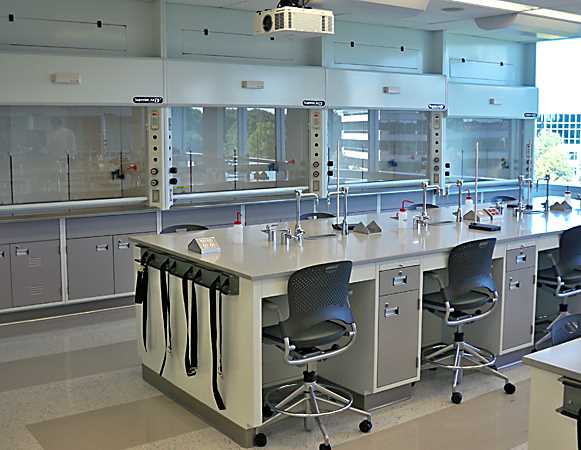Fume Hoods: Their Importance in Any Lab Environment
 Laboratory Fume Hood
Laboratory Fume Hood
Carroll Seating does more than just auditorium and theatre seating. We also design and install casework and other laboratory items including fume hoods.
Laboratory Casework
When you are looking into getting efficient and resilient laboratory casework to ensure the integrity of your scientific research, you may encounter a type of lab equipment called a fume hood. These devices are important for your lab work, particularly if you are working with potentially dangerous chemicals. Learn more about fume hoods, their importance as laboratory casework, and the different types of fume hoods available.
What Is a Fume Hood?
A laboratory fume hood, sometimes also known as an exhaust hood, is a device that contains a space completely enclosed to the rest of the lab environment, except for necessary ductwork connected to mechanical ventilation, as well as exhaust purposes on three sides, top, and bottom. Operated through the restricted use of arms and hands by the user, this type of laboratory casework uses the ventilation to draw fumes, gases, and vapors inwards, and exhausts them into the atmosphere outside the lab.
Purpose of a Fume Hood
The primary function of this laboratory casework is the safety of lab workers. Fume hoods accomplish this specifically by:
Isolating the fumes, vapors, and gases created by chemicals and expelling them through the laboratory’s exhaust system.
Protecting the operators and other lab workers from solid or liquid hazards, as well as chemical reactions like explosions, splashes, or fires. A sliding window, called a sash, adjusts the flow of air and determined how quickly air flows through the fume hood
Contributing to the laboratory’s overall ventilation as air flows through the hood.
Types of Fume Hood
Most laboratories use two different types of fume hoods:
Constant air volume (CAV). This type of laboratory casework pulls in and exhausts air at the same rate regardless of he position of the sash. If the sash is lowered the velocity of the airflow increases proportionally, with the effect reversed if the sash is raised.
Variable air volume (VAV). This fume hood works in conjunction with other exhaust control systems so that the velocity of the airflow responds to the status of the sash. Therefore, if the sash raises or lowers, the system modulates the velocity to keep it consistent at any time.
Best Safety Work Practices
Just like with most laboratory casework, you can maintain the efficiency of the fume hood and the overall safety of the environment by following safe practices during operation. Use the following safe work practices when operating a fume hood:
Conduct all experiments at least six inches away from the hood
Maintain the sash closed as much as possible
Handle the materials slowly and precisely
Do not use the laboratory casework as waste disposal
Keep the device free from obstructions
As you have seen, a fume hood is an essential laboratory component that protects the people in the lab and the rest of the building from dangerous chemicals and unexpected reactions. Carroll Seating provides laboratories with products from Institutional Casework Inc. The manufacturer’s specific product, the Jamestown Metal fume hood, combines maximum isolation design with approved architectural standards to create a unique, but safe, type of laboratory casework.
Interested in this device? Contact Carroll Seating today to order the best fume hood option for your work, as well as other laboratory casework needs.
Sources:
https://www.carrollseating.com/casework/laboratory-casework-2/
https://www.iciscientific.com/category/jamestown-fume-hoods-isolator-series
https://blink.ucsd.edu/safety/research-lab/chemical/hoods/index.html
https://ehs.ucsc.edu/lab-safety-manual/hoods.html
https://ehs.princeton.edu/node/367





























